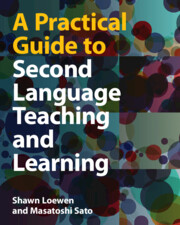Book contents
- A Practical Guide to Second Language Teaching and Learning
- Reviews
- A Practical Guide to Second Language Teaching and Learning
- Copyright page
- Dedication
- Contents
- Figures
- Tables
- Preface
- Acknowledgments
- 1 Language Acquisition
- 2 Second Language Acquisition
- 3 Instructed Second Language Acquisition
- 4 Input, Interaction, and Output
- 5 Grammar
- 6 Vocabulary
- 7 Pronunciation
- 8 Pragmatics
- 9 Academic Language Skills
- 10 Cognitive Individual Differences
- 11 Psychological Individual Differences
- 12 Social Individual Differences
- 13 The Research–Practice Dialogue
- Key Terms
- Index
- References
4 - Input, Interaction, and Output
Published online by Cambridge University Press: 03 May 2024
- A Practical Guide to Second Language Teaching and Learning
- Reviews
- A Practical Guide to Second Language Teaching and Learning
- Copyright page
- Dedication
- Contents
- Figures
- Tables
- Preface
- Acknowledgments
- 1 Language Acquisition
- 2 Second Language Acquisition
- 3 Instructed Second Language Acquisition
- 4 Input, Interaction, and Output
- 5 Grammar
- 6 Vocabulary
- 7 Pronunciation
- 8 Pragmatics
- 9 Academic Language Skills
- 10 Cognitive Individual Differences
- 11 Psychological Individual Differences
- 12 Social Individual Differences
- 13 The Research–Practice Dialogue
- Key Terms
- Index
- References
Summary
This chapter discusses the necessary components of second language acquisition, that is, input, interaction, and output. While all language learning theories support the importance of input (written and spoken), they diverge in ways which input is connected to second language acquisition. The chapter then examines some of the second language acquisition theories, such as the interaction hypothesis, the noticing hypothesis, the cognitive-interactionist approach, the output hypothesis, and sociocultural theory, all of which explains how interaction leads to second language acquisition. The chapter moves onto specific pedagogical frameworks that support interaction, including communicative language teaching and task-based language teaching. Finally, the chapter delves into the role that output plays by discussing its functions for second language acquisition.
Keywords
Information
- Type
- Chapter
- Information
- Publisher: Cambridge University PressPrint publication year: 2024
